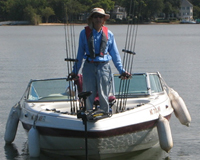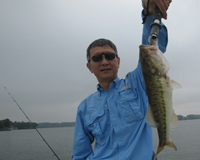Dr. Wang has been inducted into the Clinical Engineering Hall of Fame in recognition for using the scientific method and quantitative data analysis to advance clinical engineering, for leading the opposition to unnecessary and overly burdensome regulatory control and, above all, for enhancing patient safety in the deployment of health technology.
Dr. Wang holds Bachelor of Science degrees in both Physics and Electronics Engineering from the University of Sao Paulo, Brazil, and earned a Doctor of Science (ScD) degree from the Massachusetts Institute of Technology (MIT). He has received numerous awards from a number of prestigious organizations, including 2 ACCE Management Achievement awards (1999 and 2001), 2 best paper awards from AAMI's BI&T magazine (2006 and 2013), the 2010 AAMI Clinical/Biomedical Engineering Achievement Award, and the 2015 ACCE Lifetime Achievement Award. He was elected a fellow of ACCE in 2000 and fellow of the American Institute of Medical and Biological Engineering (AIMBE) in 2003.
Below are some excerpts from the supporting material provided for his nomination.
“Our clinical engineering profession arose from scientific and technical support to medicine – largely due to the growth of technology in patient care. The clinical environment and its needs and the regulatory environment that grew up around the technology were, in my view, somewhat [by] “trial and error”. Changes based upon opinion as much as science marked our history: e.g., publicity about micro shock, rapid adoption of legislation (e.g., California) and standards (e.g., NFPA), evolving accreditation (e.g., TJC) and regulation (e.g., FDA SMDA). Binseng challenged commonly accepted beliefs with data, contributing greatly to our transition to a more rational, science-based profession… Binseng’s data-based approaches to scheduled maintenance and to accreditation/regulation were often in opposition to conventional wisdom and tradition. He challenged established concepts and our processes across the spectrum, from basic issues to complex and esoteric considerations. He brought data to the regulatory environment while providing advice for meeting requirements to the profession.”
“Professional engineering is a science-based discipline, the practical application of scientific principles. It is discouraging to observe that clinical engineering still struggles to find a sound scientific footing for its practices. Binseng brings discipline and rigor to the effort… Binseng has made many contributions to the profession. In recent years, he has produced a landmark series of publications that combine statistical analysis and thoughtful insight. Without Binseng, clinical engineering would largely be a just another group of opinionated practitioners… Binseng’s voice has been heard throughout the clinical engineering profession and beyond. But I want to focus on two of his characteristics that I try to emulate. The first is principled skepticism, his refusal to accept conventional wisdom without good reason. The second is intellectual courage, his insistence on careful thought and thoughtful action. I am continually challenged by his example.” “I would like to say that my opinion of Binseng is that he is the consummate professional in every sense of the word. He is extremely knowledgeable and smart. He researches and prepares everything that he does professionally to the nth degree… Binseng is quite dedicated to nurturing his fellow professionals, particularly those who are less experienced, and hoping to follow his way forward… Binseng’s leadership in the area of invoking an evidence-based approach to PM is refreshingly novel and quite indisputable… He is also blessed with a great sense of fun and has made several impressive and well-prepared appearances on the Technical Iconoclast platform at the annual AAMI meeting.”
“Binseng is a tireless champion of patient safety through better selection, acquisition, maintenance and operation of medical technologies. He sees the relationships among these steps as hospitals and other healthcare settings make choices of equipment, plan for the installation and commissioning of the equipment, develop the maintenance and repair services and develop the education and training of the operators of the equipment. His comprehensive view of how medical equipment impacts the lives of patients and the professional capabilities of the operators have helped assure safe, effective diagnosis, treatment and monitoring of thousands of patients.”
“Binseng has been an intellectual leader for the field of Clinical engineering over his career and is highly respected by the leaders in the field. Binseng has written extensively about the subject of productivity and the objectives and analysis of the impact and results of PM. He definitively described at conferences and wrote articles about productivity in clinical engineering services. He developed models and measurements of productivity that are the standard of the industry.”
“Binseng is recognized as an industry authority on clinical engineering, technology planning, evidence based maintenance and most areas of medical technology management. Of the many dedicated colleagues, I’ve known and come to appreciate, I can say he is perhaps one of, if not the most intelligent and candid. Whether he and I were agreeing on issues, I have always made a point to listen to him because I could count on him to make an intelligent argument that often informed and ultimately influenced my opinions… Binseng has demonstrated an earnest commitment to our profession and to quality healthcare. As a consequence of the effort he consistently puts into his activities and his obvious commitment, he is one of those professionals who has come to be recognized and greatly valued by his CE/HTM colleagues and the healthcare professionals he has interfaced with.”
“He is one of the few authors who publishes objective data that he analyzes using statistical methods to support important conclusions regarding the benchmarking of HTM activities. The high quality of his numerous publications improves the perception of the field of Clinical Engineering… Wang has worked tirelessly to share his knowledge and improve the quality of the Clinical Engineering community throughout the world. I have personally seen his contributions in Latin America and Asia. He has a substantial international reputation as a speaker, author, and educator. I am particularly impressed with the very high quality of his work, which is always thoroughly grounded in mathematical principles. In addition to his high scientific accomplishments, he has an excellent sense of humor and has shared that both in private and in public at the AAMI national meetings in the technical iconoclast session.”
"My recommendation is based on numerous remarkable contributions and skills I have observed since I first met him at ECRI in the early 1980s. He was visiting ECRI to create a formal collaboration with his Clinical Engineering Department in Brazil's Campinas University, and I had the good fortune of becoming his US liaison at ECRI. At his request, I spoke at the 1st Brazilian Clinical Engineering Conference and visited his lab in 1985. I discovered that his staff and engineering services were quite "world class"… In that visit, I also learned that Dr. Wang's department was widely acclaimed globally, and was already designated a WHO Collaborator Center!... Though Dr. Wang's tireless contributions to Clinical Engineering are well known through his regular insightful and outspoken publications, few realize that he has a remarkable biomedical engineering research folio as well. He was hired by the State of Sao Paulo from his University to run their huge Secretariat of Health’s technology procurement and management program in the 1980s, and within just a few years he was recruited by the US NIH to conduct ground-breaking research in the burgeoning digital imaging field. Dr. Wang's published NIH research in the 1990s on fusing 3D images from CT, MRI and EEG is astounding, especially since his hard work VASTLY predated the virtually reality and computer generated graphics tools that we take for granted today. His NIH research was a tribute to his MIT doctorate PLUS close scrutiny of ACCE records will show that during his NIH stay he became one of ACCE's founders!"
| "structure" |
"process" |
"outcome" |
 |
 |
 |
Binseng trying to explain the concept of Evidence-Based Maintenance using fishing analogy.